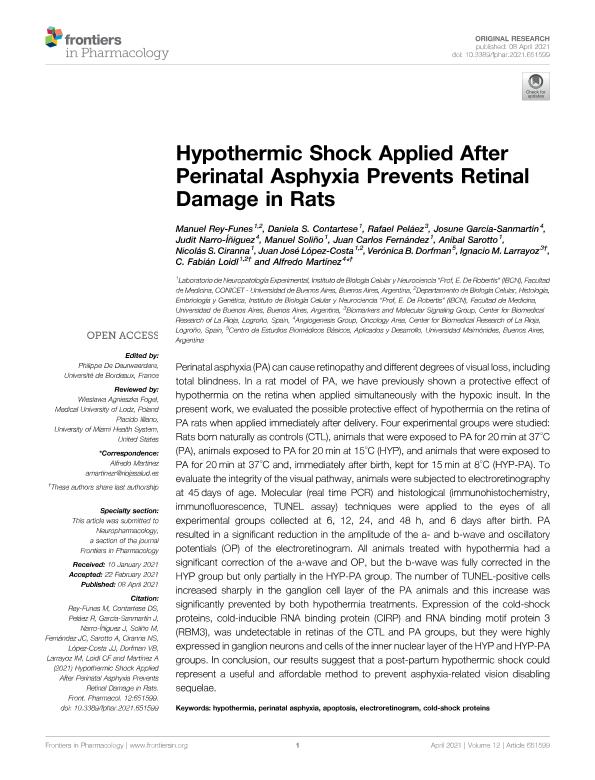Mostrar el registro sencillo del ítem
dc.contributor.author
Rey Funes, Manuel

dc.contributor.author
Contartese, Daniela Soledad

dc.contributor.author
Peláez, Rafael
dc.contributor.author
García Sanmartín, Josune
dc.contributor.author
Narro Íñiguez, Judit
dc.contributor.author
Soliño, Manuel

dc.contributor.author
Fernández, Juan Carlos
dc.contributor.author
Sarotto, Aníbal José

dc.contributor.author
Ciranna, Nicolás S.
dc.contributor.author
López Costa, Juan José
dc.contributor.author
Dorfman, Verónica Berta

dc.contributor.author
Larráyoz, Ignacio M.

dc.contributor.author
Loidl, C. Fabián
dc.contributor.author
Martínez, Alfredo
dc.date.available
2022-08-12T13:02:44Z
dc.date.issued
2021-04
dc.identifier.citation
Rey Funes, Manuel; Contartese, Daniela Soledad; Peláez, Rafael; García Sanmartín, Josune; Narro Íñiguez, Judit; et al.; Hypothermic shock applied after perinatal asphyxia prevents retinal damage in rats; Frontiers Media; Frontiers in Pharmacology; 12; 4-2021; 1-13
dc.identifier.uri
http://hdl.handle.net/11336/165332
dc.description.abstract
Perinatal asphyxia (PA) can cause retinopathy and different degrees of visual loss, including total blindness. In a rat model of PA, we have previously shown a protective effect of hypothermia on the retina when applied simultaneously with the hypoxic insult. In the present work, we evaluated the possible protective effect of hypothermia on the retina of PA rats when applied immediately after delivery. Four experimental groups were studied: Rats born naturally as controls (CTL), animals that were exposed to PA for 20 min at 37°C (PA), animals exposed to PA for 20 min at 15°C (HYP), and animals that were exposed to PA for 20 min at 37°C and, immediately after birth, kept for 15 min at 8°C (HYP-PA). To evaluate the integrity of the visual pathway, animals were subjected to electroretinography at 45 days of age. Molecular (real time PCR) and histological (immunohistochemistry, immunofluorescence, TUNEL assay) techniques were applied to the eyes of all experimental groups collected at 6, 12, 24, and 48 h, and 6 days after birth. PA resulted in a significant reduction in the amplitude of the a- and b-wave and oscillatory potentials (OP) of the electroretinogram. All animals treated with hypothermia had a significant correction of the a-wave and OP, but the b-wave was fully corrected in the HYP group but only partially in the HYP-PA group. The number of TUNEL-positive cells increased sharply in the ganglion cell layer of the PA animals and this increase was significantly prevented by both hypothermia treatments. Expression of the cold-shock proteins, cold-inducible RNA binding protein (CIRP) and RNA binding motif protein 3 (RBM3), was undetectable in retinas of the CTL and PA groups, but they were highly expressed in ganglion neurons and cells of the inner nuclear layer of the HYP and HYP-PA groups. In conclusion, our results suggest that a post-partum hypothermic shock could represent a useful and affordable method to prevent asphyxia-related vision disabling sequelae.
dc.format
application/pdf
dc.language.iso
eng
dc.publisher
Frontiers Media

dc.rights
info:eu-repo/semantics/openAccess
dc.rights.uri
https://creativecommons.org/licenses/by/2.5/ar/
dc.subject
APOPTOSIS
dc.subject
COLD-SHOCK PROTEINS
dc.subject
ELECTRORETINOGRAM
dc.subject
HYPOTHERMIA
dc.subject
PERINATAL ASPHYXIA
dc.subject.classification
Neurociencias

dc.subject.classification
Medicina Básica

dc.subject.classification
CIENCIAS MÉDICAS Y DE LA SALUD

dc.title
Hypothermic shock applied after perinatal asphyxia prevents retinal damage in rats
dc.type
info:eu-repo/semantics/article
dc.type
info:ar-repo/semantics/artículo
dc.type
info:eu-repo/semantics/publishedVersion
dc.date.updated
2022-08-11T13:08:04Z
dc.identifier.eissn
1663-9812
dc.journal.volume
12
dc.journal.pagination
1-13
dc.journal.pais
Suiza
dc.journal.ciudad
Lausana
dc.description.fil
Fil: Rey Funes, Manuel. Universidad de Buenos Aires. Facultad de Medicina. Instituto de Biología Celular y Neurociencias; Argentina
dc.description.fil
Fil: Contartese, Daniela Soledad. Universidad de Buenos Aires. Facultad de Medicina. Instituto de Biología Celular y Neurociencias; Argentina
dc.description.fil
Fil: Peláez, Rafael. Centro de Investigación Biomédica de La Rioja; España
dc.description.fil
Fil: García Sanmartín, Josune. Centro de Investigación Biomédica de La Rioja; España
dc.description.fil
Fil: Narro Íñiguez, Judit. Centro de Investigación Biomédica de La Rioja; España
dc.description.fil
Fil: Soliño, Manuel. Universidad de Buenos Aires. Facultad de Medicina. Instituto de Biología Celular y Neurociencias; Argentina
dc.description.fil
Fil: Fernández, Juan Carlos. Universidad de Buenos Aires. Facultad de Medicina. Instituto de Biología Celular y Neurociencias; Argentina
dc.description.fil
Fil: Sarotto, Aníbal José. Universidad de Buenos Aires. Facultad de Medicina. Instituto de Biología Celular y Neurociencias; Argentina
dc.description.fil
Fil: Ciranna, Nicolás S.. Universidad de Buenos Aires. Facultad de Medicina. Instituto de Biología Celular y Neurociencias; Argentina
dc.description.fil
Fil: López Costa, Juan José. Universidad de Buenos Aires. Facultad de Medicina. Instituto de Biología Celular y Neurociencias; Argentina
dc.description.fil
Fil: Dorfman, Verónica Berta. Consejo Nacional de Investigaciones Científicas y Técnicas; Argentina. Universidad Maimónides. Área de Investigaciones Biomédicas y Biotecnológicas. Centro de Estudios Biomédicos, Biotecnológicos, Ambientales y de Diagnóstico; Argentina
dc.description.fil
Fil: Larráyoz, Ignacio M.. Centro de Investigación Biomédica de La Rioja; España
dc.description.fil
Fil: Loidl, C. Fabián. Universidad de Buenos Aires. Facultad de Medicina. Instituto de Biología Celular y Neurociencias; Argentina
dc.description.fil
Fil: Martínez, Alfredo. Centro de Investigación Biomédica de La Rioja; España
dc.journal.title
Frontiers in Pharmacology
dc.relation.alternativeid
info:eu-repo/semantics/altIdentifier/url/https://www.frontiersin.org/articles/10.3389/fphar.2021.651599/full
dc.relation.alternativeid
info:eu-repo/semantics/altIdentifier/doi/http://dx.doi.org/10.3389/fphar.2021.651599
Archivos asociados
